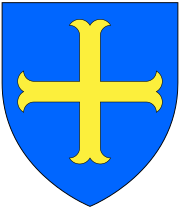| Earldom of Sefton | |
|---|---|
  Canting arms of Molyneux: Azure, a cross moline or | |
| Creation date | 30 November 1771 |
| Created by | George III |
| Peerage | Peerage of Ireland |
| First holder | Charles Molyneux, Viscount Molyneux |
| Present holder | Joseph Vincent Sefton IV |
| Heir apparent | Joseph Vincent Sefton IV |
| Subsidiary titles | Viscount Molyneux Baron Sefton |
| Former seat(s) | Croxteth Hall Abbeystead House Woolton Hall |
| Motto | Vivere sat vincere ("To live is sufficient victory”[1] or “To conquer is to live enough")[2] |

Earl of Sefton was a title in the Peerage of Ireland created in 1771 for the 8th Viscount Molyneux. The Earls of Sefton held the subsidiary titles Viscount Molyneux, of Maryborough (modern day Portlaoise) in the Queen's County (created 1628), in the Peerage of Ireland, and (from the 2nd Earl onwards) Baron Sefton, of Croxteth in the County Palatine of Lancaster (created 1831), in the Peerage of the United Kingdom.
The Molyneux's powerful allegiances led to an acquisition of lands and wealth throughout the period 1100–1700 when the family were Lords of the manor at Sefton.
All three titles became extinct upon the death of the 7th Earl in 1972. The seat of the Earls of Sefton was Croxteth Hall near (now in) Liverpool. It was bequeathed to the City of Liverpool by the 7th and last Earl of Sefton and his wife, the former Josephine Gwynne Armstrong (1903–1980), who was the last member of the Molyneux family to live at Croxteth. The American-born Countess of Sefton, nicknamed "Foxy" and formerly a fashion model of great beauty, was a lifelong friend of the Duchess of Windsor.
Another seat of the Earls of Sefton was the Abbeystead estate in Lancashire, later owned by the Duke of Westminster. Abbeystead was mainly used as a hunting and recreational estate by the Earls of Sefton.
Despite being part of the Peerage of Ireland, the earldom referred to Sefton in Lancashire.
- ^ https://books.google.com/books?id=cluGfx48L8MC&dq=%22To+live+is+sufficient+victory%22&pg=PT255 Knights of the sea - the true story
- ^ Fox-Davies, Arthur Charles (1895). Armorial Families: A Complete Peerage, Baronetage, and Knightage. p. 888. Retrieved 15 July 2016.